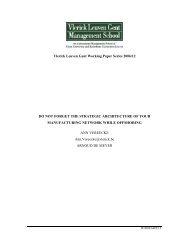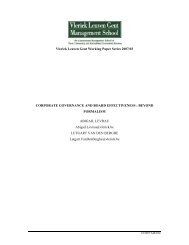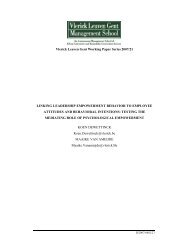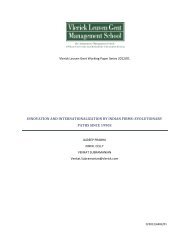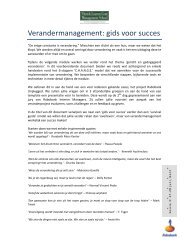an experimental investigation of the interactions ... - Vlerick Public
an experimental investigation of the interactions ... - Vlerick Public
an experimental investigation of the interactions ... - Vlerick Public
Create successful ePaper yourself
Turn your PDF publications into a flip-book with our unique Google optimized e-Paper software.
I. INTRODUCTIONWhile a lot <strong>of</strong> firms have eagerly embraced intra-firm cooperation as a key aspect <strong>of</strong> <strong>the</strong>irstrategy, <strong>the</strong> challenge that <strong>the</strong>se firms face is to to refrain employees from taking decisions thatbenefit <strong>the</strong>ir own department or business unit but harm <strong>the</strong> firm as a whole (Galbraith 2007;Jorgensen <strong>an</strong>d Messner 2009; Roberts 2004). Consequently, m<strong>an</strong>agers must underst<strong>an</strong>d howemployees c<strong>an</strong> be instigated to act in <strong>the</strong> best interest <strong>of</strong> <strong>the</strong> firm. Over <strong>the</strong> past several decades,researchers in several domains have cast light over <strong>the</strong> way employees take <strong>the</strong>ir decisions. A mainfinding is that employee decisions are influenced by <strong>the</strong> economic structure <strong>of</strong> <strong>the</strong> firm. Typically, <strong>the</strong>economic structure consists <strong>of</strong> various formal mech<strong>an</strong>isms such as incentive systems <strong>an</strong>d informationsystems (Milgrom <strong>an</strong>d Roberts 1992). A burgeoning literature, on <strong>the</strong> o<strong>the</strong>r h<strong>an</strong>d, demonstrates thatdescriptive social norms, which describe how things are usually done in a firm, are also veryinfluential in shaping employee decisions (Cialdini et al. 1990; 2000; Cialdini 2007; Cialdini <strong>an</strong>d Trost2010). Consistent with <strong>the</strong> findings <strong>of</strong> this line <strong>of</strong> research, firms invest a lot <strong>of</strong> money in social eventsto develop descriptive social norms that propagate <strong>the</strong> import<strong>an</strong>ce <strong>of</strong> intra-firm cooperation. Thougha lot <strong>of</strong> studies have focused on ei<strong>the</strong>r <strong>the</strong> economic structure or <strong>the</strong> social structure as adetermin<strong>an</strong>t <strong>of</strong> employee behavior, recent efforts have begun to explore <strong>the</strong> <strong>interactions</strong> between<strong>the</strong> economic <strong>an</strong>d social structure <strong>of</strong> <strong>the</strong> firm (Bloomfield <strong>an</strong>d Tayler 2010; Coletti et al. 2005; Fisher<strong>an</strong>d Huddart 2008).This study complies with <strong>the</strong> idea that <strong>the</strong> economic <strong>an</strong>d social structure <strong>of</strong> <strong>the</strong> firm areintertwined <strong>an</strong>d provides <strong>the</strong>ory <strong>an</strong>d <strong>experimental</strong> evidence to suggest that <strong>an</strong> import<strong>an</strong>tcharacteristic <strong>of</strong> <strong>the</strong> economic structure <strong>of</strong> <strong>the</strong> firm - whe<strong>the</strong>r all formal mech<strong>an</strong>isms are designed toinduce employees to act in <strong>the</strong> firm’s best interest or not - determines <strong>the</strong> import<strong>an</strong>ce <strong>of</strong> descriptivesocial norms for guiding employee decisions. The notion <strong>of</strong> alignment <strong>of</strong> a combination <strong>of</strong> formalmech<strong>an</strong>isms with <strong>the</strong> firm’s best interest is inextricably intertwined with <strong>the</strong> observation thatemployees are influenced by multiple formal mech<strong>an</strong>isms when making decisions (Merch<strong>an</strong>t <strong>an</strong>d V<strong>an</strong>der Stede 2007; Roberts 2004). In this perspective, a combination <strong>of</strong> formal mech<strong>an</strong>isms is alignedwith <strong>the</strong> firm’s best interest if all formal mech<strong>an</strong>isms motivate employees to act in <strong>the</strong> firm’s bestinterest. Such a combination provides employees with a coherent message about <strong>the</strong> expectedbehavior. A combination <strong>of</strong> formal mech<strong>an</strong>isms is misaligned with <strong>the</strong> firm’s best interest if not allformal mech<strong>an</strong>isms induce employees to act in <strong>the</strong> firm’s best interest. 1Despite <strong>the</strong> inconsistencywith equilibrium assumptions, misaligned combinations <strong>of</strong> formal mech<strong>an</strong>isms are highly prevalent in1 For ease <strong>of</strong> notification, we will use ‘aligned combinations <strong>of</strong> formal mech<strong>an</strong>isms’ when we refer to combinations <strong>of</strong>formal mech<strong>an</strong>isms in which all formal mech<strong>an</strong>isms are aligned with <strong>the</strong> firm’s best interest. ‘Misaligned combinations <strong>of</strong>formal mech<strong>an</strong>isms’ refer to combinations in which not all formal mech<strong>an</strong>isms are aligned with <strong>the</strong> firm’s best interest.Note that this definition implies that one formal mech<strong>an</strong>ism has to be aligned with <strong>the</strong> firm’s best interest.4



